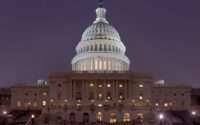Dominique Dwor-Frecaut, a former associate with the New York Fed and outlier from the rest of the financial-market pack, is standing by a bold call she made a year ago: She says the Federal Reserve needs to hike its benchmark interest rate to 8%, versus the current level of 4.5%-4.75%, to stabilize inflation and could still get there.
The U.S. hasn’t seen an 8% fed-funds rate since July-October 1990 — when inflation as measured by the annual headline consumer-price index hovered between 4.8% and 6.3% — but such a level makes sense to Dwor-Frecaut. That’s because it is tied to the Taylor Rule — a generally accepted rule of thumb used to determine where interest rates ought to be relative to the current state of the economy. Based on January U.S. data, the annual headline CPI rate was 6.4%, while the unemployment rate stood at a more-than-half-century low of 3.4%.
A stream of stronger-than-expected data indicates that the U.S. economy is holding up far better than many had expected after almost a full year of Fed rate hikes. That surprising strength is giving rise to the possibility that policy makers will need to once again boost the size of their next rate increases, after having dialed down their Feb. 1 hike to a quarter of a percentage point. Minutes of the Fed’s Jan. 31-Feb. 1 meeting revealed that all policy makers wanted to keep hiking rates and they generally saw the need to stay in a restrictive policy stance until inflation clearly comes down to 2%.
Read: Fed minutes show ‘some’ officials thought easier financial conditions could mean tighter monetary policy
Financial markets are finally coming around to the Fed’s message of ongoing rate increases, as bond investors factor in additional rate hikes for this year. Treasury yields have followed the trajectory of rate expectations and trended higher. Meanwhile, global bonds — which move in the opposite direction of yields — are in the process of erasing all of the gains they’ve made this year, based on the Bloomberg Global-Aggregate Total Return Index.
“The Fed is going to need to double down because we are coming out of several decades of very low interest rates, in which households and businesses have been able to lock in very low interest rates for a very long time,” said Dwor-Frecaut, now a Los Angeles-based senior strategist for research provider Macro Hive of London.
“The U.S. is more immune to monetary-policy tightening than it was 10 years ago because of household deleveraging and very strong balance sheets. Policy tightening hasn’t been strong enough to have enough of an impact, even in interest-rate-sensitive markets like housing where prices have stabilized.” (Even so, existing home sales have dropped for 12 straight months, according to data released on Tuesday.)
Dwor-Frecaut’s reasoning boils down to three key points: that the U.S. is caught in a high inflation regime in which “wages and prices have become entangled, just as in the 1970s and 1980s”; monetary policy remains “too loose”; and the Fed could fall further behind the curve, given the long time it takes for rate increases to filter through the economy.
She said the fed-funds rate should already be around 8% — within the estimated range cited by former Fed regional presidents Jeffrey Lacker and Charles Plosser and economists at Stifel, Nicolaus & Co., and a bit above the 7% level envisioned by St. Louis Fed President James Bullard in November.
As of Thursday, traders saw a 48.2% chance of the Fed lifting borrowing costs to 5.25% to 5.5% by July, and 29.3% chance of something higher, but that still won’t be enough to get the job done, according to Dwor-Frecaut, who describes herself as someone who revels “in challenging the consensus, though even the consensus can be right sometimes.”
In relying on the Taylor Rule, she said that “I tried to find something as simple as possible and not impacted by technical issues. What struck me is that if you looked at the fed-funds rate and Taylor Rule since the 1970s, the story again, again and again is that the Fed starts tightening when the gap between the Taylor Rule and actual fed-funds rate is wide, and stops when it has closed.”
The Taylor Rule is a “crude but simple and practical way of capturing macroeconomic imbalances,” and, by waiting until the gap is wide before tightening, policy makers are “always having to play catch up,” said Dwor-Frecaut, who worked as a senior associate in market operations monitoring and analysis at the New York Fed from 2016 to 2018. “The thing that is striking about this tightening cycle is that they [Fed officials] started when the gap was the biggest since the 1970s oil shock,” putting them behind the curve.
On Thursday, a day after the release of the Fed’s minutes, U.S. stocks
DJIA,
SPX,
COMP,
closed higher after a choppy session, while the 10-year Treasury yield fell below 3.9% and the ICE U.S. Dollar Index
DXY,
was little changed at 104.56.
In terms of the nature of inflation, “it’s both a supply and demand shock as it was in the 70s,” according to Dwor-Frecaut. “The commonality is that if you plot wages against inflation, you will see a feedback loop between the two. This negative feedback loop is what’s going to make it super-hard to bring down.”
In addition, she said, the reopening of China and its possible impact on global energy prices could be one possible trigger that sends the U.S. into an inflationary shock, “which would be a disaster for the U.S.”


